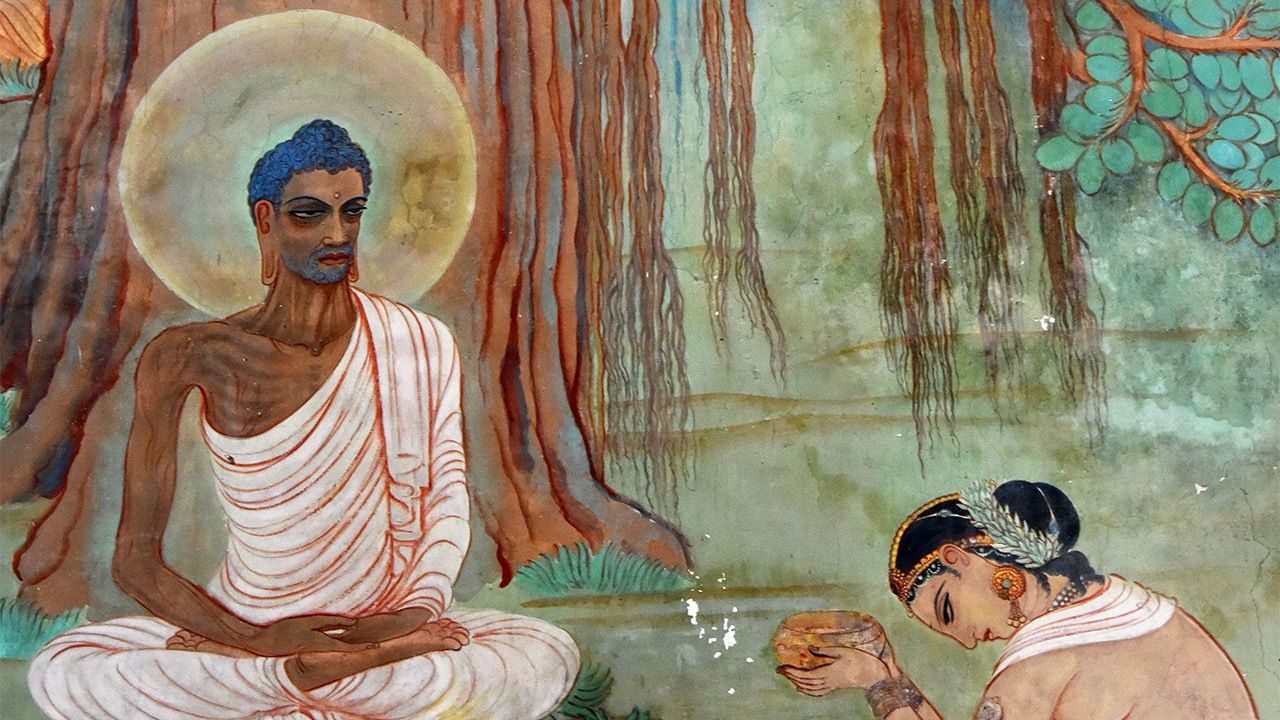Meditation as a method of alleviating suffering
2,500 years ago, Buddhism was born in India, founded by someone known historically as Siddhartha Gautama. Born into an aristocratic family in the kingdom of Kapilavastu, close to what is now known as the India-Nepal border, he spent his early years in luxury and comfort. And if he had remained a prince, Siddhartha might have become king. But when he was young, his eyes were opened to the suffering of human existence. This realization prompted him to renounce his princely status and his comfortable and wealthy lifestyle, and venture into the forest alone to live the religious life of an ascetic.
What prompted him to leave this comfortable environment to live an uncertain and uncomfortable life?
During his youth, Siddhartha realized that there were happy and unhappy people in society. Though our circumstances are unique to each other, we have one thing in common: we are all inevitably affected by old age, disease, and death. So we are all equally unhappy. The fact of life implies suffering itself, and this pain cannot be relieved or cured by wealth or social status. For someone who understood this truth, the privilege of being born a prince no longer had any meaning. The only path left for Siddhartha was to dedicate his life to finding a way to escape the inherent sufferings of life in order to attain a state of calm and peace.
In a forest far from civilization, the young man studied with monks who had also broken away from society to practice meditation and asceticism. He tests his body by inflicting physical torture on himself and subjecting it to starvation, hoping to overcome pain to gain superhuman strength that will allow him to escape suffering. But after six years of self-deprecation and sacrifice, he still hasn’t reached his goal. So he decided to change his approach by abandoning his extreme austerities to focus solely on meditation. Thanks to this method, he finally managed to attain enlightenment under the famous Bodhi tree. After this attainment, he became known as the Buddha, which means “the enlightened one”. He is also known as Shakyamuni, referring to his origins in the Shakya tribe of ancient India.
Manual for coping with destructive emotions
What is the nature of Buddha’s enlightenment? It was impossible for anyone to completely understand the upheaval that might occur in another person’s heart. For this reason, the exact story of the Buddha’s experience of attaining enlightenment remains a mystery. However, we can get a rough idea of what happened by reading the sutras and many other Buddhist scriptures, which draw from the Buddha’s teachings based on his experience.
The Buddha taught that one can only be free from suffering through one’s own efforts. No superhuman can come and free a person from his illness. This is why the Buddha used the benefits of meditation to examine his own heart and mind until he found the root of suffering. He then understood that the root cause of unhappiness was attachment to the illusion of a sense of self.
We allow ourselves to be controlled by an ego that doesn’t really exist. Egocentric, we see the world in a way that serves the interests of this imaginary ego. This “selfish” consciousness is something that has developed in us by instinct, but this worldview is wrong. And these misunderstandings lead to confusion and destructive states of mind that Buddhism calls “kleshas”. This includes emotions such as anxiety, desire, jealousy and fear, mental states that cloud the mind and lead to harmful actions that fuel the cycle of suffering.
Understanding the origins of unhappiness through self-observation, the Buddha developed practical guidelines for ending these unhealthy states of mind and freeing oneself from the ocean of suffering. This approach to spiritual training is unique to Buddhism.
Buddhist practice consists of two main elements. The first is to study the sutras and other writings in order to achieve a good understanding of Buddhist teachings. The Sutras serve as a guide for the practice of Buddhism. The second is to practice the spiritual lessons learned in the writings under the guidance of more experienced students.
As a completely new teaching method, Buddhism has a strong appeal to people. The Buddha quickly attracted many disciples, and without discriminating between them, taught them the methods he had learned from his own experience. After his death at the age of 80, his followers continued to maintain his methods and teachings. Even today, Buddhists around the world continue to follow them. Under the orders of the Buddha, his followers adapted the spiritual meditation practice he had established for them. This community soon became one of the main pillars in the development of Buddhism as a religion over the following centuries.
Defend the Sangha
The Buddha created this religion so that society would develop according to strict rules, which is probably one of the main reasons why his teachings have survived uninterruptedly for 25 centuries. He gathered his students into a single community under his leadership, which was called the “Sangha”. The group is governed by a strict code of conduct called the Vinaya Pitaka (which is one of the three most important collections of Buddhist scriptures). After his death, his followers continued to uphold these regulations and maintain the Sangha as a self-governing community of individuals governed by Buddhist law. From the very beginning, the Sangha formed the cornerstone of Buddhism. It has many advantages.
1/ Maintain the relationship between teacher and students
The Vinaya Pitaka establishes a clear relationship between teacher and disciple in the Sangha. This made it possible to transmit the Buddhist teachings, in the form of sutras and other writings, with fidelity through the centuries, but also facilitated the transmission of meditation techniques and other Buddhist practices, which could be learned directly. to students from generation to generation. This contributed to making the Sangha a very rational educational organism.
2/ Gotong royong as a form of social security
The foundation of the gotong royong system within the Sangha made it possible to transform the classical relationship between a teacher and his students into a system of gotong royong in everyday life. Thus, religious who have decided to move away from secular life to devote themselves to Buddhist practice benefit from protection but also from some kind of insurance against disease, injury, and the effects of aging. The Sangha thus becomes a system of mutual support and assistance that its members can trust.
3/ Nurturing society through alms
The Sangha of Buddhist monks is a community governed by Buddhist Law, whose members lead humble and blameless lives, guided by a strict code of ethics. This example of integrity has earned him the respect of the centuries-old outside world. People saw the Buddha’s disciples as individuals living under strict discipline, and so many wanted to support them by offering alms-food. The contributions of these people have sustained the Sangha to this day.
4/ Free from external authorities
By operating as an organization with its own laws and regulations, the Sangha has managed to achieve a certain degree of autonomy. This has been an important factor in minimizing the risk of interference from outside forces, and maintaining a suitable environment for meditation and reflection. The Sangha has functioned throughout history as an autonomous community, independent from secular authorities.
Of course, these four characteristics have not been perfectly preserved without interruption for 2,500 years. Throughout history, many events have come to prevent the proper maintenance of these basic principles. But the fact that these four elements have existed since the origins of Buddhism as the basic principles of religion is very important. Even if the Sangha occasionally fails to stay on track, it is relatively easy to get the community back on track, because the Sangha has important foundations to return to.
Japanese Buddhism, very different from its beginnings
The features of early Buddhism can be summed up in two important points. First, the goal of religious life is meditation. Buddhism does not rely on outside saviors. Students use their own powers of observation to introspect, analyze their minds, and improve themselves. Daily meditation practice is their main method to achieve this goal.
Second, the existence of the Sangha as a community provides an environment for students to focus on the path to enlightenment. The Sangha was founded with the aim of enabling followers to devote themselves to religious practice while remaining dependent on the surrounding secular society for their daily needs. The community is run rationally according to the code of discipline written in the Vinaya Pitaka.
These two characteristics set Buddhism apart from other religions, but in their Japanese form they completely atrophied. We can even say without exaggeration that they have disappeared. This is an important point in understanding the Japanese form of this religion. If it has lost these distinctive elements of early Buddhism, what other features has it developed in its place? In this series of articles, we will look at how this religion was received in Japan after arriving from China.
The place of Buddhism in the archipelago has changed a lot over the centuries. At certain periods, this religion maintained close ties with the rulers and rulers of that time. At other times, he was subjected to terrible persecution, even exiled. Let’s look together at the long and turbulent history of Buddhism and examine the unique path of the religion founded by Shakyamuni in Japan over the last fifteen centuries.
(Photo caption: Wall mural depicting the life of Buddha at the Mulagandhakuti Vihara temple, Sarnath, near Varanasi, in the Indian state of Uttar Pradesh. Aflo)

“Twitter junkie. Hipster-friendly bacon expert. Beer ninja. Reader. Communicator. Explorer. Passionate alcohol geek.”







